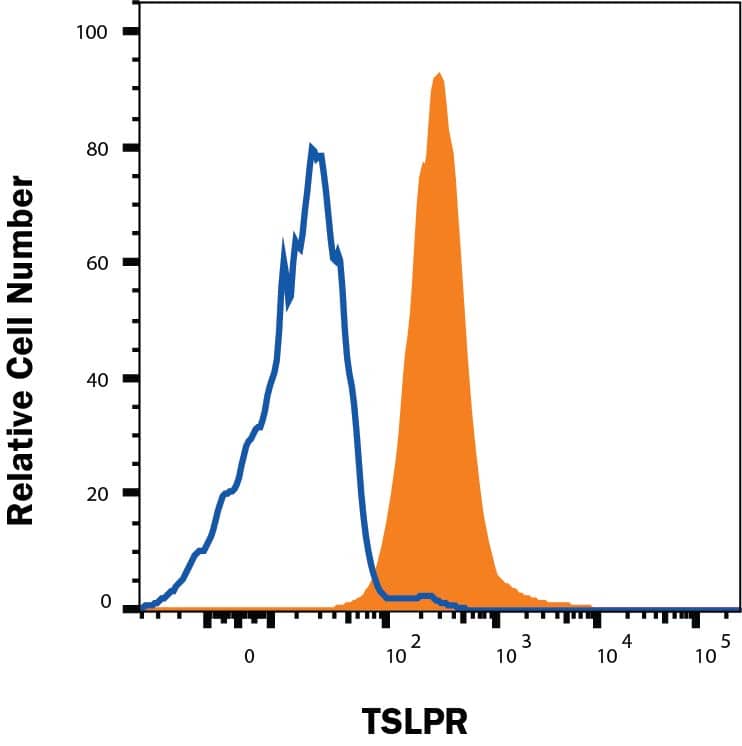Human TSLPR Antibody
R&D Systems, part of Bio-Techne | Catalog # MAB981R

Key Product Details
Species Reactivity
Applications
Label
Antibody Source
Product Specifications
Immunogen
Gly25-Lys231
Accession # Q9HC73
Specificity
Clonality
Host
Isotype
Scientific Data Images for Human TSLPR Antibody
Detection of TSLPR in NS0/hTSLPR cells by Flow Cytometry.
NS0/hTSLPR cells were stained with Mouse Anti-Human TSLPR Monoclonal Antibody (Catalog # MAB981R, filled histogram) or isotype control antibody (Catalog # MAB002, open histogram), followed by Phycoerythrin-conjugated Anti-Mouse IgG Secondary Antibody (Catalog # F0102B). View our protocol for Staining Membrane-associated Proteins.Detection of TSLPR in NS0 cells by Flow Cytometry.
NS0 cells transfected with hTSLPR (A) vs Irrelevant NS0 transfectant cells (B) were stained with Mouse Anti-Human TSLPR Monoclonal Antibody (Catalog # MAB981R, filled histogram) followed by Phycoerythrin-conjugated Anti-Mouse IgG Secondary Antibody (Catalog # F0102B). View our protocol for Staining Membrane-associated Proteins.Applications for Human TSLPR Antibody
Flow Cytometry
Sample: NS0/hTSLPR cells and NS0 cells transfected with hTSLPR vs Irrelevant NS0 transfectant cells
Western Blot
Sample: Recombinant Human TSLPR Fc Chimera (Catalog # 981-TR)
Formulation, Preparation, and Storage
Purification
Reconstitution
Formulation
Shipping
Stability & Storage
- 12 months from date of receipt, -20 to -70 °C as supplied.
- 1 month, 2 to 8 °C under sterile conditions after reconstitution.
- 6 months, -20 to -70 °C under sterile conditions after reconstitution.
Background: TSLPR
TSLPR, also named Delta (1) and CRLM-2 (2) (cytokine receptor-like module-2), was originally cloned as a novel type 1 cytokine receptor with similarity to the common gamma chain. It was subsequently identified to be a subunit of the cellular receptor for the IL-7-like cytokine TSLP and termed TSLPR (3). The human TSLPR cDNA encodes a 371 amino acid (aa) residue type 1 membrane protein with a 22 aa residue signal peptide, a 210 aa residue extracellular domain, a 20 aa residue transmembrane domain, and a 119 aa residue cytoplasmic domain (4, 5). The extracellular region contains two fibronectin type III-like domains and a WSXWS-like motif. The cytoplasmic domain contains a membrane-proximal box 1 motif that is known to be important for association with JAKs (4). Human TSLPR displays 39% identity to mouse TSLPR and 24% identity to the common gamma receptor (4). An alternatively spliced mRNA variant encoding a soluble TSLPR has also been reported in mouse (2). TSLPR expression is ubiquitous in the immune and hematopoietic cells, but is up-regulated in Th2-skewed cells. Cells expressing TSLPR alone bind TSLP with low affinity. Co-expression of TSLPR and IL-7 R alpha is required for high-affinity TSLP binding and signal transduction (3‑6). The TSLPR and IL-7 R alpha are co‑expressed primarily on monocytes and dendritic cells and at lower levels in lymphoid cells. TSLP has been shown to induce the release of T cell-attracting chemokines from monocytes and enhance the maturation of CD11c+ dendritic cells (5).
References
- Fujio, K. et al. (2000) Blood 95:2204.
- Hiroyama, T. et al. (2000) Biochem. Biophys. Res. Commun. 272:224.
- Park, L.S. et al. (2000) J. Exp. Med. 192:659.
- Tonozuka, Y. et al. (2001) Cytogenet. Cell Genet. 93:23.
- Reche, P.A. et al. (2001) J. Immunol. 167:336.
- Pandey, A. et al. (2000) Nat. Immunol. 1:59.
Long Name
Alternate Names
Gene Symbol
UniProt
Additional TSLPR Products
Product Documents for Human TSLPR Antibody
Product Specific Notices for Human TSLPR Antibody
For research use only

